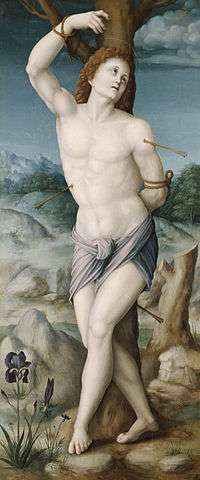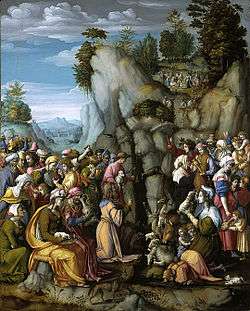Francesco Bacchiacca
Francesco d'Ubertino Verdi, called Bachiacca (say “bah ki ah ka”).[1] He is also known as Francesco Ubertini, il Bacchiacca (1494–1557). He was an Italian painter of the Renaissance whose work is characteristic of the Florentine Mannerist style.

Life
Bachiacca was born and baptized in Florence on 1 March 1494 and died there on 5 October 1557.[2]

Bachiacca belonged to a family of at least five, and possibly as many as eight artists. His father Ubertino di Bartolomeo (ca. 1446/7-1505) was a goldsmith, his older brother Bartolomeo d'Ubertino Verdi (aka Baccio 1484-c.1526/9) was a painter, and his younger brother Antonio d'Ubertino Verdi (1499–1572)—who also called himself Bachiacca—was both an embroiderer and painter. Francesco's son Carlo di Francesco Verdi (-1569) painted and Antonio's son Bartolomeo d'Antonio Verdi (aka Baccino -1600) worked as an embroiderer. This latter generation probably continued to produce paintings and embroideries after Bachiacca's death and until the Verdi family extinguished about the year 1600.[3]
Bachiacca apprenticed in Perugino's Florentine studio, and by 1515 began to collaborate with Andrea del Sarto, Jacopo Pontormo and Francesco Granacci on the decoration of cassone (chest), spalliera (wainscot), and other painted furnishings for the bedroom of Pierfrancesco Borgherini and Margherita Acciauoli.[4] In 1523, he again participated with Andrea del Sarto, Franciabigio and Pontormo in the decoration of the antechamber of Giovanni Benintendi.[5] While he established a reputation as a painter of predellas and small cabinet pictures, he eventually expanded his output to include large altarpieces, such as the Beheading of St. John the Baptist, now in Berlin.
In 1540, Bachiacca became an artist at the court of Duke Cosimo I de' Medici (reg. 1537-1574) and Duchess Eleanor of Toledo. In this capacity, Bachiacca was a colleague and peer of the most important Florentine artists of the age, including Pontormo, Bronzino, Francesco Salviati, Tribolo, Benvenuto Cellini, Baccio Bandinelli, and his in-law, the sculptor Giovanni Battista del Tasso.
Bachiacca's first major commission was to paint the walls and ceiling of the duke's private study with plants, animals and a landscape, which remain an important testimony of Cosimo's interest in botany and the natural sciences.[6]
Work
Only one signed work by Francesco is known, the decoration of a Terrace for the duchess and her children, with his abbreviated Christian name and nickname: "FRANC. BACHI. FACI."[7] His works typically contain carefully observed illustrations of nature. The artist's trademark method and style consists of the combination of figures, exotic costumes and other motifs acquired from Italian artists and German and Netherlandish prints into entirely new compositions. These cosmopolitan assemblages exhibited the most praiseworthy elements of both Flemish and Italian Renaissance art, which appealed to his courtly clientele.

Bachiacca also made cartoons for two series of tapestries, the Grotesque Spalliere (1545–49) and the Months (1550–1553), which were woven by the newly founded Medici tapestry works.[8]
As a court painter, Bachiacca created Saint Sebastian during the 1530s-1540s, on the subject of the death of Saint Sebastian, a Christian nobleman condemned to death by the Roman emperor Diocletian. Originally it was surmised that the panel could have functioned as a section to an altarpiece.[9]
Works
His works include:
- Madonna and Child at the Metropolitan Museum of Art New York, early 1520s. This painting was used as a 2018 Christmas stamp by the United States Postal Service.
- Predella with the Life of St. Achatius, and the Ten Thousand Martyrs,1521 at the Uffizi Gallery online
- Portrait of a Young Lute Player, 1524-25, New Orleans Museum of Art
- Ghismonda with Heart of Guiscardo, 1520s, Lowe Art Museum, University of Miami, Also here, and Verso and Recto
- Madonna and Child with St. John, c. 1525, Dallas Museum of Art
- Saint Sebastian, c. 1530s-1540s, Birmingham Museum of Art
- The Gathering of Manna, c. 1540/1555, National Gallery of Art, Washington D.C.
- Deposition c. 1518 at the Web Gallery of Art
- Conversion of Saint Paul 1530-1535 at the Memorial Art Gallery, Rochester, New York
Gallery
 Madonna and Child in a Landscape
Madonna and Child in a Landscape.jpg) St. Lawrence
St. Lawrence- Ghismonda with Heart of Guiscardo
- Ghismonda, reverse
.jpg) Eve with Cain and Abel
Eve with Cain and Abel Portrait of a young lady holding a cat
Portrait of a young lady holding a cat
References
- The correct period spelling (and the one used by the artist himself) is Bachiacca, with one initial c, like Machiavelli (not "Macchiavelli" [sic]). Italian scholars also prefer Bachiacca, whereas Anglophone scholars favor Bacchiacca [sic]. La France 2008, 127.
- In the Renaissance, the Florentine New Year began on 25 March, the Feast of the Annunciation. Thus, the birth date is recorded in documents as 1 March 1493 in the Florentine manner, would be 1 March 1494 in the modern manner. Archivio dell'Opera di Santa Maria del Fiore, Florence, Battesimi maschi 1492-1501, 33v.
- La France 2008, 32-38.
- La France 2008, 141-150, cat. 8-13.
- La France 2008, 174-80, cat. 32-33
- La France 2008, 220-223, cat. 65; Francesco Vossilla, "Cosimo I, lo scrittoio del Bachiacca, una carcassa di capodoglio e la filosofia naturale," and Maria Adele Signorini, "Sulle piante dipinte del Bachiacca nello scrittoio di Cosimo I a Palazzo Vecchio," Mitteilungen des Kunsthistorischen Institutes in Florenz 37, no. 2/3 (1993): 381-407.
- La France 2008, 364-267, cat. 89.
- La France 2008, 229-244, cat. 69-78 and 257-264, cat. 85-88; Lucia Meoni, Gli arazzi della collezione fiorentina: le manifatture medicee da Cosimo I a Cosimo II, 1545-1621 (Florence: Sillabe), 1998, 172-184 and 143-146.
- Birmingham Museum of Art (2010). Birmingham Museum of Art : guide to the collection. Birmingham, Ala: Birmingham Museum of Art. p. 159. ISBN 978-1-904832-77-5.
Sources
External links

- Italian Paintings: Florentine School, a collection catalog containing information about Bacchiacca and his works (see pages: 193-195; MMA #38.178).